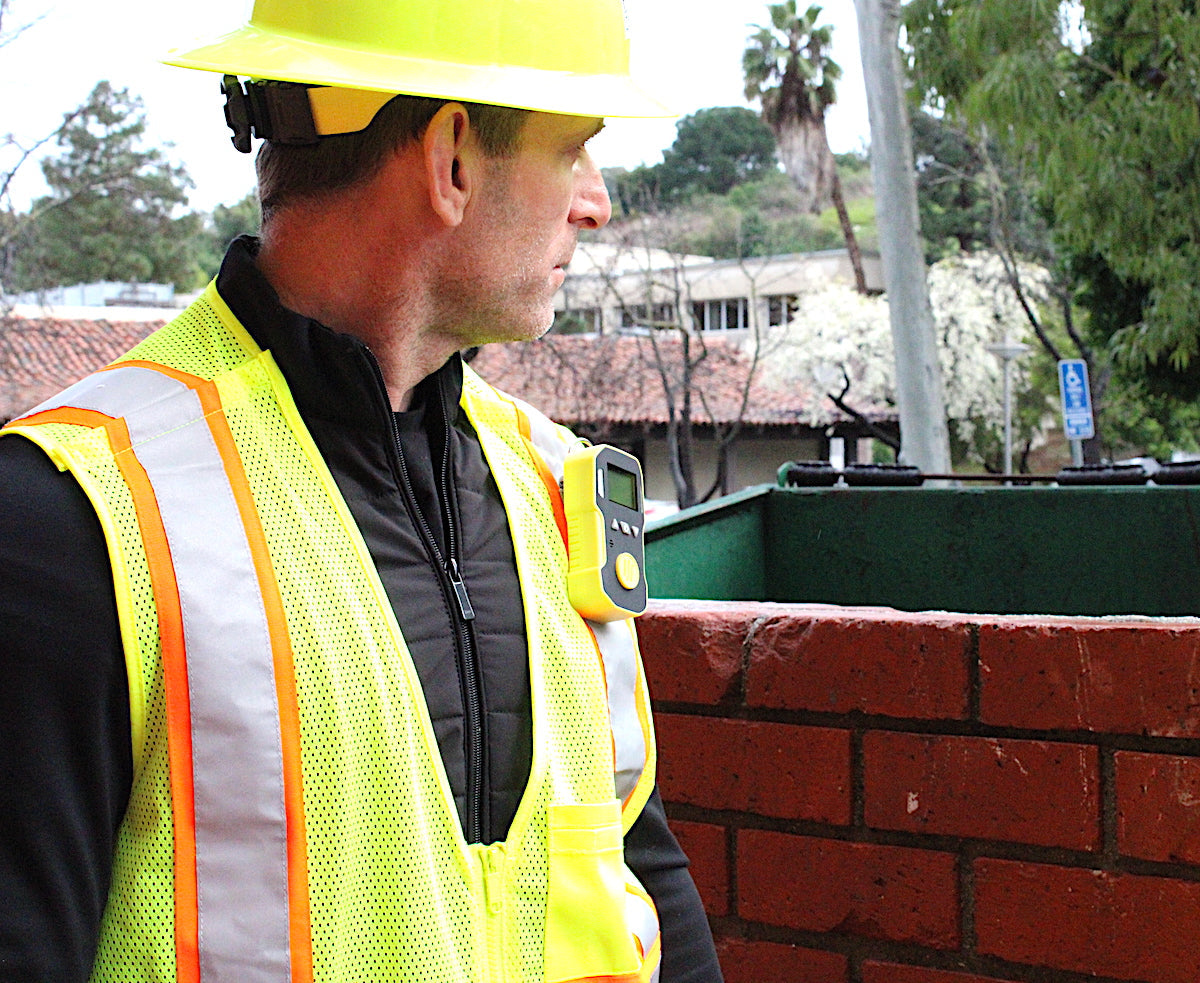A Phosgene gas detector is crucial for safety in industrial settings where chemical hazards are a concern. Phosgene, a colorless gas with a distinctive odor resembling freshly cut hay or grass, represents one of the most dangerous industrial chemicals in use today. Despite its toxicity, phosgene remains essential in various manufacturing processes. Phosgene gas detectors serve as a critical line of defense against this potentially lethal gas, providing early warning systems that can prevent serious health consequences.
| Pros | Cons |
|---|---|
| ✅ A Phosgene gas detector detects deadly gas before reaching harmful levels. | ⛔ Requires regular calibration (every 12 months). |
| ✅ Phosgene gas detectors are available as portable units. | ⛔ Sensors have limited lifespan (2-3 years for electrochemical). |
| ✅ Helps maintain compliance with OSHA exposure limits. | ⛔ Environmental factors can affect accuracy. |
| ✅ A Phosgene gas detectors are affordable safety items. |
What is the Best Phosgene Detector?
- Forensics Detectors Phosgene Gas Detector
- Draeger Phosgene Gas Monitor
- MPower Phosgene Gas Detector
What is Phosgene?
Phosgene (COCl₂) is a colorless gas at room temperature with a characteristic odor often described as similar to freshly cut hay or moldy hay. This chemical compound was infamously used as a chemical warfare agent during World War I, but today serves primarily as an industrial reagent and building block in synthetic chemistry.
What is a Phosgene Detector?
A phosgene detector is a specialized gas detection device designed to identify the presence of phosgene gas in ambient air. These devices employ various detection technologies to measure phosgene concentrations, often in parts per million (ppm) or parts per billion (ppb), and alert personnel when levels exceed predetermined safety thresholds.
Modern phosgene detectors come in several forms:
-
Fixed Gas Detection Systems: Permanently installed at strategic locations throughout facilities where phosgene is used or could be produced. These systems monitor continuously and can trigger facility-wide alarms, ventilation responses, or emergency shutdowns.
-
Portable Gas Detectors: Handheld or wearable devices that allow workers to monitor phosgene levels in their immediate vicinity. These are essential for maintenance workers or emergency responders entering areas where phosgene might be present.
-
Personal Monitoring Badges: Chemical-reactive cards or badges worn by workers that change color when exposed to phosgene, providing a visual indication of exposure.
-
Analytical Instruments: Laboratory-grade equipment that can detect and measure phosgene with high precision, typically used for research or forensic purposes.
Who Needs a Phosgene Detector?
Phosgene detectors are essential safety equipment for:
-
Chemical Manufacturing Facilities: Companies that directly work with phosgene or use it as an intermediate in chemical processes.
-
Pharmaceutical Industries: Many pharmaceutical manufacturing processes involve chemicals that can generate phosgene as a byproduct.
-
Plastic and Polymer Manufacturers: Particularly those producing polycarbonates and polyurethanes where phosgene is a key ingredient.
-
Refrigeration Technicians: Phosgene can form when refrigerants containing chlorinated compounds decompose under high heat (such as when welding near refrigeration lines).
-
Firefighters and Emergency Responders: First responders may encounter phosgene during industrial fires, especially those involving chlorinated solvents.
-
Laboratories: Research and quality control labs working with chemicals that might generate phosgene.
-
Military and Defense Personnel: For detecting potential chemical warfare agents or training purposes.
-
Waste Treatment Facilities: Where chemical waste processing might inadvertently generate phosgene.
-
Metal Fabrication Shops: Welding operations on metal surfaces with chlorinated cleaning solvents can produce phosgene.
Why is Phosgene Dangerous?
Phosgene represents a severe health hazard primarily due to its effects on the respiratory system. Its danger stems from several factors:
Delayed Symptoms
Unlike many toxic gases that cause immediate distress, phosgene exposure may not cause severe symptoms for hours. This "latent period" means individuals can be exposed to dangerous levels without realizing it until serious damage has occurred.
Pulmonary Edema
The primary cause of death from phosgene exposure is pulmonary edema – fluid buildup in the lungs. Phosgene reacts with proteins in the pulmonary alveoli, damaging the capillary-alveolar membrane and causing fluid to leak into the lungs.
Low Odor Threshold vs Toxicity Level
While phosgene has a detectable odor at approximately 0.4-1.5 ppm, this level already exceeds the immediately dangerous to life and health (IDLH) concentration of 2 ppm. By the time someone smells phosgene, they may already be exposed to harmful levels.
Chemical Burns
Beyond respiratory effects, phosgene can cause chemical burns to the eyes, skin, and mucous membranes.
Formation from Common Chemicals
Phosgene can be inadvertently created when chlorinated solvents (like those in many cleaning products) are exposed to high heat, making it a hidden danger in seemingly routine operations.
The health effects of phosgene exposure progress from initial eye and respiratory tract irritation to coughing, choking sensation, and chest tightness, followed by development of pulmonary edema (4-24 hours later), and potentially respiratory failure and death in severe cases.
How Often Should Phosgene Detectors Be Calibrated?
Calibrate phosgene detectors at least every 12 months.
What is the Detection Limit for Most Phosgene Detectors?
Modern phosgene detectors typically detect between 0.01-0.05 ppm (10-50 ppb). High-end analytical instruments can detect even lower levels. Since OSHA's permissible exposure limit is 0.1 ppm (8-hour average), most industrial detectors reliably measure at and below this threshold to ensure worker safety.
What's the Difference Between Fixed and Portable Phosgene Detectors?
Fixed detectors are permanently installed for continuous area monitoring and connect to central alarm systems, triggering automated emergency responses. Portable detectors are handheld or wearable devices for personal protection and spot-checking. They offer mobility but have shorter battery life and need more frequent maintenance. Most facilities use both types for comprehensive protection.
Can Environmental Factors Affect Phosgene Detector Accuracy?
Yes. Temperature extremes alter sensor sensitivity, humidity interferes with detection methods, pressure changes affect readings, other gases cause false positives, and dust blocks sensor access. Quality detectors include temperature and pressure compensation to minimize these effects. Always use detectors within their specified environmental operating ranges.
What Should I Do If My Phosgene Detector Alarm Activates?
Evacuate immediately, moving upwind. Alert others to evacuate. Use respiratory protection if available and trained. Notify emergency personnel. Don't return until declared safe. Seek medical attention even if you feel fine, as symptoms can be delayed. Report the incident per facility protocols.
Can Phosgene Be Detected By Smell Before Reaching Dangerous Levels?
No. Relying on smell is extremely dangerous. While phosgene smells like freshly cut hay, the odor threshold (0.4-1.5 ppm) is already at dangerous exposure levels. Olfactory fatigue quickly sets in, making it undetectable after brief exposure. Some people cannot detect the odor at all. Always rely on proper detection equipment.
Some Facts About Phosgene Gas Detectors:
✅ Phosgene gas detectors are specialized instruments designed to measure and monitor concentrations of phosgene gas in industrial environments.
✅ Phosgene (COCl₂) is a colorless, highly toxic gas used in manufacturing processes and can also form when chlorinated solvents are exposed to high heat.
✅ These detectors typically utilize electrochemical sensors or infrared spectroscopy for accurate measurement at parts per billion (ppb) levels.
✅ Professional-grade phosgene detectors offer features like real-time monitoring, multiple alarm systems, and data logging capabilities for workplace safety compliance.
✅ Detection equipment ranges from portable personal monitors to fixed installation systems, with sensitivities well below OSHA's permissible exposure limit of 0.1 ppm.
What are Phosgene Exposure Limits?
Phosgene (COCl₂) exposure limits are as follows:
- OSHA: The Occupational Safety and Health Administration (OSHA) has established a Permissible Exposure Limit (PEL) of 0.1 parts per million (ppm) for phosgene as an 8-hour time-weighted average.
- NIOSH: The National Institute for Occupational Safety and Health (NIOSH) also recommends an exposure limit of 0.1 ppm as a time-weighted average for up to a 10-hour workday.
- ACGIH: The American Conference of Governmental Industrial Hygienists (ACGIH) recommends a Threshold Limit Value (TLV) of 0.1 ppm as an 8-hour time-weighted average.
The IDLH (Immediately Dangerous to Life and Health) concentration is set at 2 ppm, indicating the extreme toxicity of this gas even at very low concentrations.
Final Word
The selection of a reliable phosgene gas detector remains crucial for maintaining workplace safety and regulatory compliance. Professional-grade detection equipment, featuring highly sensitive sensors and comprehensive alarm systems, provides the necessary safeguards against phosgene exposure risks. Regular maintenance, proper calibration, and trained personnel ensure these detectors deliver optimal performance, making them an indispensable tool in industrial safety management.
About The Author
Dr. Kos Galatsis ("Dr.Koz") is the President of FORENSICS DETECTORS where the company operates from the scenic Palos Verdes Peninsula in Los Angeles, California. He is a subject matter expert on gas sensor technology, gas detectors, gas meters, and gas analyzers. He has been designing, building, manufacturing, and testing toxic gas detection systems for over 20 years.

Every day is a blessing for Dr. Koz. He loves to help customers solve their unique problems. Dr. Koz also loves spending time with his wife and his three children going to the beach, grilling burgers, and enjoying the outdoors.
Read more about Forensics Detectors.
Email: drkoz@forensicsdetectors.com

